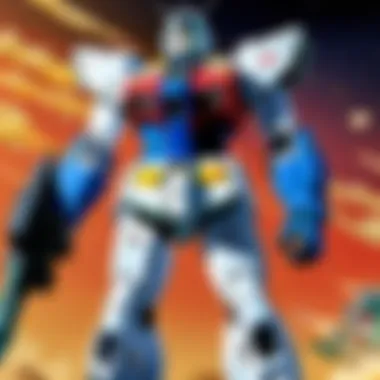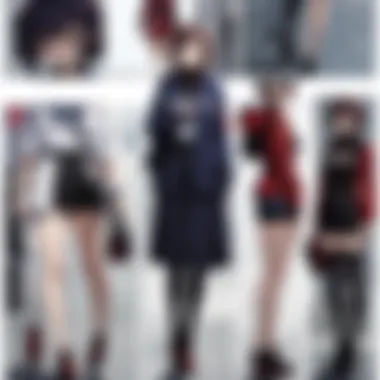Exploring Gundam: The Origin's Impact and Evolution


Intro
Series Overview
Synopsis and Premise
Notable Characters
- Char Aznable: Known as the enigmatic Red Comet, Char’s journey encapsulates ambition, rivalry, and the weight of ancestry.
- Sayla Mass: Char's half-sister, whose personal story of conflict against familial ties enriches the narrative framework.
- Casval Rem Deikun: Char’s persona before he assumes the role of the infamous commander, merging personal ambition and sociopolitical critique.
- Dozle Zabi: A contrast to Char, representative of the Zabi family, depicted with depth that humanizes the antagonist perspective.
Each character is marked with distinctive arcs, allowing viewers to grasp not just their motivations, but also the broader implications of their actions on the war’s evolution.
Themes and Motifs
Major Themes Explored
- Conflict and Morality: The series raises questions about moral boundaries in war, challenging how characters navigate their beliefs amid chaos.
- Psychological Struggles: Characters often wrestle with their past, illuminating the psychological toll of warfare and loss.
- Ideology vs. Reality: The story ponders the impacts of political ideologies on personal relationships, examining how grand narratives clash with real human experiences.
Symbolism in Storytelling
The series is rife with symbolism, effectively utilizing mecha design and battles to reflect inner turmoil. For instance, the Gundam itself isn’t just a weapon; it signifies hope and the fight for freedom. The design choices reflect emotional states, creating a dialogue between character and machine that enriches the viewing experience.
“In every character, there lies a story waiting to unfurl, nestled within the conflicts they face.”
Artistic Style and Animation
Visual Aesthetics and Design
Animation Techniques and Trends
The animation stands out for its fluid action sequences, which are choreographed with notable precision. Techniques such as digital painting and CGI are employed to bring massive battle scenes to life, ensuring that every clash between mobile suits resonates with intensity.
Artists meticulously animate every frame, enabling the narrative's depth to shine through the visuals. This progression not only showcases technical skill but also reflects an evolution in style, vital for capturing the audience's attention in a crowded market.
Historical Context
Overview of the Gundam Franchise


The Gundam franchise stands as a monumental cultural phenomenon within Japan and beyond. Since its introduction, it has expanded its reach through numerous TV series, films, novels, and merchandise. Spanning multiple timelines, Gundam's core themes often revolve around war, peace, and the philosophical implications of advanced technologies like mechs and AI.
The robust world of Gundam encompasses diverse story arcs that often intersect, leading to a complex narrative environment. From Mobile Suit Gundam Wing to Gundam Seed, each series adds layers to the original lore while introducing its particular twists and character arcs.
- Key Elements of the Franchise:
- Diverse timelines: Each series contributes a unique perspective on the Universal Century and its implications.
- Iconic mechs: The mobile suits have become almost synonymous with the franchise, inspiring countless replicas and fan creations.
- Philosophical inquiries: Themes relating to human nature and the consequences of war are profoundly explored.
Narrative Structure
Narrative structure serves as the backbone of any story, and in
Plot Development
A notable aspect is how the storytelling navigates flashbacks that add depth to characters while propelling the plot. These moments create a rich tapestry, weaving past experiences with current events, allowing viewers to understand the motives that shape their actions. The ingenious deployment of foreshadowing prepares audiences for twists and turns without revealing too much, maintaining suspense and compelling viewers to keep watching.
Character Motivation
On the other hand, Sayla Mass's motivations reflect hope and a desire for understanding, contrasting sharply with Char’s often destructive drive. This juxtaposition creates a compelling dynamic between the characters and encourages viewers to reflect on their personal ethics and the cost of conflict.
Ultimately, the motivations are not simply character backgrounds; they are narratives in themselves that interlink with overarching themes of war, loss, and redemption.
Conflict and Resolution
The resolution of these conflicts, however, is not straightforward. Instead of neatly tying up each story arc, the series invites contemplation and prompts questions about what true resolution looks like in an imperfect world. The climactic confrontations leave an indelible mark, illustrating the idea that victory does not equate to happiness, nor does defeat spell the end of hope.
Character Profiles
Analyzing characters allows the audience to connect on a deeper level. It’s not simply about who they are but also about what they represent and how their personal journeys embody the narrative’s essence.
Having a keen understanding of each key character and their motivations fosters a holistic appreciation of the series.
Key Characters: An Analysis
- Char Aznable
- Amuro Ray
- Sayla Mass
- Ramba Ral
- Known as the "Red Comet," Char is not just an antagonist; he embodies the struggle against established norms. His complexities arise from a blend of revenge and visionary ideals, making him a fascinating study in duality. His masked presence represents both his anonymity and his deeply personal vendetta.
- As the reluctant hero, Amuro’s journey from a naive boy to a seasoned pilot speaks volumes about growth under pressure. His relationship with technology is pivotal—he’s not just a user but often a creator, reflecting the human capacity to adapt and evolve.


- Sayla is an embodiment of resilience. Navigating through her tumultuous relationship with her brother, Char, and the harsh realities of war, she represents the all-too-human struggle to find one’s identity amidst chaos.
- Though a minor character, Ramba serves to indicate the honor and code some soldiers still hold. His old-school warrior mentality contrasts with the new wave of conflict, enriching the narrative through his interactions with Amuro and technique in battle.
Development Arcs
- Char Aznable’s Evolution: Char starts off primarily as a symbol of revenge. Over time, his aspirations define him further, blurring the line between hero and villain. His decisions resonate with a deep-rooted quest not just for personal redemption but for transformative vision across the universe.
- Amuro Ray’s Transformation: Initially seen as a young man overwhelmed by circumstances, Amuro’s evolution into a seasoned warrior represents the loss of innocence. His arc is a poignant reflection of how conflict shapes character, pushing him to harness strength he didn’t know existed.
- Sayla Mass's Journey:
Sayla’s arc is one of discovery—she seeks to balance her familial ties and personal beliefs. The strain of choices, particularly her relationship with Char, highlights the emotional turbulence experienced by those living in war-impacted settings.
These arcs intertwine with the central themes of the series, reflecting the many facets of human experience, the toll of war, and the quest for identity in a landscape where everything is at stake.
"In the midst of conflict, it's often the human elements that shine through, revealing truths that transcend battle lines."
Artistic Evolution
Visual Style and Animation Techniques
Frames are meticulously crafted, with significant attention given to background artistry. Each setting feels distinctive, echoing the era and environment that shaped the characters’ realities. This commitment to creating a visually engaging world enables audiences to immerse themselves fully in the narrative. The utilization of CGI is particularly noteworthy, as it enhances mecha battles and renders action sequences exhilarating to behold. You can see how kinetic energy flows through every clash, gripping the audience’s attention.
Moreover, the decision to tell the story with such dynamic visual storytelling isn’t merely aesthetic; it serves a thematic purpose as well. For example, the way the color contrasts the mood in various settings reflects the character's emotional states and inner turmoil.
Character Design and Mecha Aesthetics
- Mecha Aesthetics: The designs often incorporate realistic mechanics that speak volumes about the lives lost in battles. Each Gundam has its own personality, shaped by the operator.
- Character Representation: Striking a balance between heroic and antagonistic elements is vital, allowing characters to be relatable irrespective of their roles in the conflict.
War and Its Consequences
Thematically, the series provocatively illustrates how war engenders a cycle of hatred and revenge, leaving behind a trail of destruction. The character Shrise, for instance, embodies this struggle as his life is profoundly affected by the violent events that unfold around him, forcing him to navigate the dichotomies of duty and morality.
"War affects people in unseen ways. It lingers long after the conflict ends, shaping destinies and altering lives forever."
Through personal stories intertwined with historical events, the series fosters a dialogue about the consequences of warfare, making it an essential part of the Gundam legacy.
Human Relationships in Crisis
For example, the relationship between Char Aznable and his father serves as a poignant backdrop to the narrative, highlighting how ideological differences can fracture familial ties. These dynamics expose vulnerabilities and the emotional toll of war, engaging viewers in a reflection on their own relationships. In times of crisis, it’s not just about survival but about the connections we maintain.
Technology vs. Humanity


As the series progresses, characters confront the implications of their technological creations. The constant battle between embracing innovation for greater good versus the potential threat it poses forms a critical theme. The narrative doesn’t provide easy answers but rather encourages critical thinking about the future trajectories of humanity and machine.
Cultural Impact and Reception
Influence on Contemporary Anime
- Narrative Depth: The interwoven stories in The Origin challenge the traditional formats seen in earlier anime. Following the evolution of characters like Char Aznable and Sayla Mass, viewers are treated to a character-driven narrative that diverges from the often straightforward good vs. evil arcs common in the genre.
- Complex Themes: Unlike many series, which may shy away from hot-button topics, The Origin embraces them, prompting audiences to engage with issues like military ethics, identity, and the consequences of technological advancements. This willingness to tackle the uncomfortable has influenced newer series to adopt similar approaches, fostering a more mature landscape in anime storytelling.
- Cross-Generational Appeal: The series has succeeded in attracting a diverse audience, bridging generational gaps. Older fans who grew up with the original Mobile Suit Gundam find new layers of enjoyment in The Origin, while newcomers are drawn in by its fresh take on the established lore. This ability to captivate various demographics is a tactic that many creators look to replicate.
Audience Reception and Criticism
However, critiques also surface, particularly around its pacing and the handling of established lore.
- Pacing Issues: Some viewers have noted that certain episodes feel rushed or bogged down by excessive exposition. This pacing can make it difficult for casual fans to fully appreciate the main themes without prior context.
- Deep Lore: For newcomers, the deep lore of the Gundam universe can feel overwhelming, leading to mixed feelings about accessibility. This intricate world-building may alienate those who cannot devote time to understand all nuances.
- Characterization Discrepancies: While many characters are richly fleshed out, there are moments when some personalities verge into cliches or are less developed, leading to disappointment among fans who expected to see every character shine.
Comparative Analysis with Other Gundam Series
- Narrative Depth: The Origin enriches the backstory of pivotal characters, such as Char Aznable and Sayla Mass, setting a groundwork that wasn’t fully explored in the original series. For instance, Char's motivations are laid bare, painting a picture of a man shaped by personal loss and ideals rather than one-dimensional antagonism.
- Artistry: From an artistic angle, the two series differ significantly. The Origin employs modern animation techniques, resulting in fluid movements and vibrant colors that are miles ahead of the sometimes stilted appearances of the original's scenes. This lush visual representation has the potential to captivate a new generation of viewers while retaining the charm that long-time fans recall.
- Themes of War: While both series delve into the themes of war and its consequences, The Origin places more emphasis on political intrigue and the harsh realities faced by soldiers. The humanization of characters shows a spectrum of morality, making it less about good vs. evil and more about the gray areas in between. This complexity enriches the viewing experience,
- Prequel Dynamics: Set in the Universal Century, The Origin chronicles events leading up to the One Year War, establishing a rich context that enriches the original series. This offers fans a clearer insight into how the political landscape shifted, leading to conflict.
- Interweaving Lore: By integrating elements from subsequent series, The Origin creates cross-references that entice viewers to explore older and newer titles in the franchise. Details that could easily be glossed over gain significance when seen through the lens of The Origin’s narrative.
- Impact on Future Installations: The developments in The Origin are not only revelatory on their own but also serve to influence character arcs and storylines in later Gundam series, preserving continuity while presenting fresh perspectives.
Merchandising and Spin-offs
The realm of merchandising and spin-offs in the Gundam franchise plays a pivotal role, contributing not only to the series' financial success but also to its cultural significance. This topic is crucial to understanding how
Figures, Models, and Art Books
One cannot discuss Gundam merchandising without taking a closer look at the figures, models, and art books that have become synonymous with the franchise. Bandai, a dominant force in the toy industry, has consistently released high-quality Gundam models, commonly referred to as Gunpla. These models cater to both novices and expert builders, allowing fans to recreate their favorite mecha in intricate detail.
- Collectibility: The appeal of Gunpla lies in its collectibility. Enthusiasts often aim to gather limited edition models, which typically hold significant value over time. For instance, models of iconic designs like the RX-78-2 Gundam can fetch impressive prices on the secondhand market.
- DIY Culture: The model-building experience fosters a DIY ethos within the community. Fans often share their creations on platforms like Reddit, sparking discussions around techniques and customizations. This hands-on approach enhances the connection between the fan and the franchise.
- Art Books: Alongside models, art books that highlight the breathtaking concept art and design of the series provide a window into the creative process. These publications serve as essential resources for fans who appreciate the artistic depth of 'The Origin' and its broader narrative context.
Adaptations and Extended Media
- Anime Adaptations: The OVAs that follow 'The Origin' closely correlate with the themes and storylines presented in the original manga series. This intricate transition helps maintain the original’s spirit while allowing new audiences to interact with the lore. Fans who are into anime and manga can experience the essence of these adaptations without the barrier of language, as subtitles often accompany the content.
- Expanded Universe: The existence of spin-off series and collaborations with other media, like video games and themed cafes, ensures that characters and stories from 'The Origin' reach broader audiences. For instance, some Gundam games incorporate elements from the original narrative, allowing players to immerse themselves within that universe actively.
- Community Interaction: Events like anime conventions often feature exclusive merchandise based on 'The Origin', fostering a sense of community among fans. Participating in these gatherings not only celebrates the franchise but also cultivates a shared passion among diverse fans.
Enduring Influence
This series extends its impact beyond the immediate realm of Gundam. It has served as a blueprint for genre storytelling, influencing a variety of anime that came after it. The intricacies of character motivations, underpinned by a deeper understanding of the socio-political landscape in which they operate, are reflective of a maturing medium.
- Characters like Char Aznable and Sayla Mass are not just roles; they're symbols of the intricate social fabric we see in not only anime but modern storytelling as a whole.
- The series also broadens the narrative scope, inviting discussions on war, loss, and identity—themes that resonate across cultures and generations.
Future Prospects for the Gundam Franchise
Looking ahead, there are key areas to consider:
- Technological Innovations: As new animation techniques and storytelling tools emerge, there's space for Gundam to experiment. Innovations could elevate visual storytelling, making the mechas and battles even more captivating.
- Cross-media Expansion: The trend of adapting anime into video games and novelizations can harness the depth of The Origin, allowing narratives to reach new audiences.
- Continued Exploration of Themes: As societal issues evolve, Gundam can take this opportunity to mirror these changes, tackling new dilemmas relevant to contemporary viewers.



